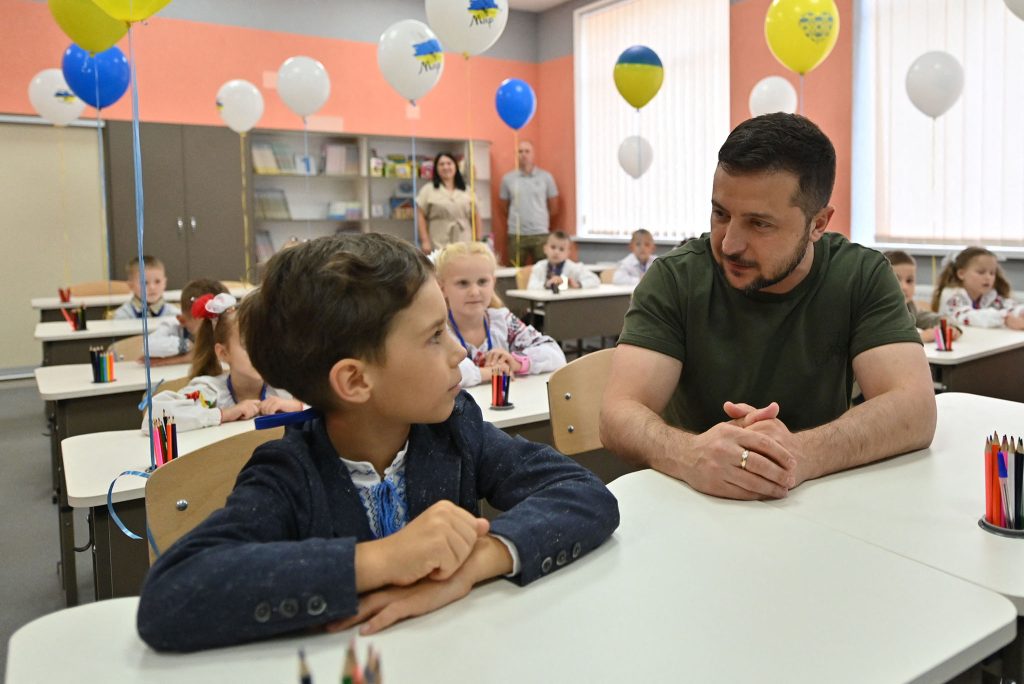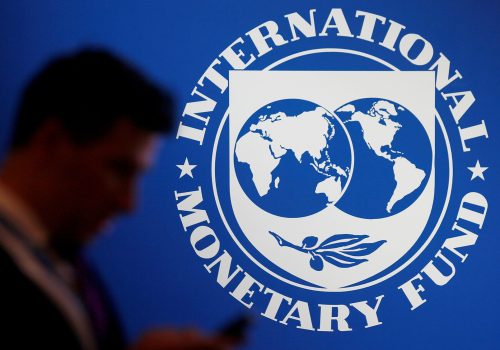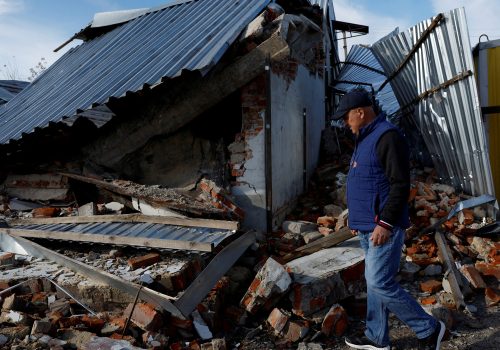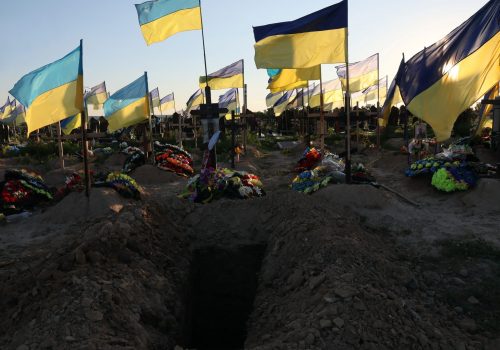The world is rightly impressed by the unexpected victories of Ukraine’s armed forces against Russia, and the collective West has provided Ukraine with plenty of modern arms. Yet arms alone are not enough. As columnist Niall Ferguson pointed out in September: “The Ukrainian army may be winning. The Ukrainian economy is losing.” As the end of the year approaches, the West needs to step up and guarantee Ukraine sufficient financing to sustain the country in 2023—and the International Monetary Fund (IMF) must play a pivotal and creative role in delivering the funds.
Russia’s war has caused the contraction of Ukraine’s economy by 35 percent (or seventy billion dollars) this year. In addition, it has caused massive material destruction that the non-governmental Kyiv School of Economics assesses at more than $120 billion. The World Bank has already assessed the total Ukrainian losses at $252 billion.
In the spring, the IMF reckoned that Ukraine’s state budget would need five billion dollars a month or about fifty billion for the whole of 2022. Alas, the total external financing pledged to Ukraine for 2022 has been only $36 billion, and only $26.5 billion has been actually dispersed—that is, about half of what is needed. (These amounts do not include military funding.)
Lacking tax revenues and sufficient foreign aid, Ukraine has little choice but to print money to finance its bare-knuckles budget, as public expenditures have been slashed to the bare minimum. As a result, inflation is rising persistently. In October, it reached 26.6 percent through no fault of the Ukrainian government.
The Ukrainian government has specified its needs for 2023, presuming that the war continues with the current intensity. In October, President Volodymyr Zelenskyy stated that Ukraine would need fifty-five billion dollars of foreign support next year, including thirty-eight billion to patch a hole in the budget and seventeen billion for the rebuilding of critical infrastructure. He expected an IMF program of some twenty billion dollars.
So far, the two dominant donors to the Ukrainian budget have been the United States and the European Union (EU). Since June, the United States has done its share, steadily giving grants of $1.5 billion a month to Ukraine, and the Biden administration intends to continue this support with $14.5 billion in 2023. This support is included in the administration’s thirty-seven billion dollar Ukraine aid request for next year, which hopefully Congress will pass during its current lame-duck session. If the administration fails to have this adopted before the end of this year, it risks substantial delay and obstruction from Donald Trump-aligned Republicans, who oppose assistance to Ukraine altogether or want to delay it by raising bureaucratic obstacles.
The European Commission is also strongly in favor of Ukraine, and it attempts to match the US financial support, though with highly subsidized loans rather than grants. The European Parliament concurs, but the European Council of twenty-seven ministers of finance has to approve any financial support, and each of them has veto powers. The German government has repeatedly caused delays in the EU disbursements to Ukraine, complaining that the EU must not increase its indebtedness.
As a result of this obstruction, the EU has only disbursed six billion euros of the nine billion it promised Ukraine last May. The European Commission is pressing hard for a decision on disbursement of eighteen billion euros to match the US contribution next year, and it harbors high hopes to be able to do so. If so, Ukraine would receive about three billion dollars a month from the United States and the EU, but on either side something can go wrong or be delayed, raising the financial risks for Ukraine.
The missing piece in the Ukrainian financial drama is the IMF. After Russia’s aggression against Ukraine in March 2014 when it annexed Crimea, the IMF announced within days that it would issue fourteen to eighteen billion dollars for a two-year rescue package for Ukraine. As the impact of the war became known, the IMF adopted a four-year program in March 2015. But at that time, the IMF had different leadership.
Current IMF Managing Director Kristalina Georgieva, by contrast, has not done what’s necessary to secure a program for Ukraine. After nine months of Russian aggression against Ukraine, the IMF has only provided $2.7 billion of emergency financing. In order to avoid offering any financing, it developed a new monitoring instrument, a Program Monitoring with Board Involvement (PMB), in October. It aims to establish a macroeconomic framework, which is indeed important. On November 23, nine months after the start of this war, the IMF finally announced that it had concluded such a staff-level program after virtual discussions, but without any financing.
In phone calls, Zelenskyy has appealed to Georgieva for an IMF program. Speaking at the International Conference on the Recovery, Reconstruction, and Modernization of Ukraine in Berlin on October 25, Georgieva stated that the “PMB would help catalyze urgently needed support from donors and pave the way for eventually moving to a full-fledged IMF program.” But neither there nor elsewhere has Georgieva explained this neglect of the primary IMF duty, to help a member country in a macroeconomic crisis by providing emergency financing.
This IMF passivity is all the more remarkable since US Treasury Secretary Janet Yellen on October 12 urged “the IMF to use the envisioned monitoring program to lay the groundwork to establish a full-fledged program for Ukraine early next year.” By contrast, she expressed her appreciation of the World Bank and European Bank for Reconstruction and Development (EBRD) for their support to Ukraine.
There are always political considerations and complications among IMF members, but its Executive Board has repeatedly voted on previous IMF programs for and disbursements to Ukraine. Russia has been the single dissenting vote, while China and India have happily supported Ukraine.
Neither Georgieva nor any other senior IMF official has visited Ukraine since Russia started this war, while Anna Bjerde, vice president of the World Bank, visited Kyiv on November 16, and leaders from most EU countries have visited the capital. The World Bank, the EBRD, and the European Investment Bank all perform important roles in helping Ukraine.
Arms are of foremost importance in a war, but Ukraine needs substantial financial support from its friends. The United States and the European Commission do what they can, but the IMF needs to provide a normal macroeconomic stabilization program with proper financing to keep Ukraine’s government functioning so its military can stay in the fight.
Anders Åslund is a senior fellow at the Stockholm World Forum. His most recent book is Russia’s Crony Capitalism: The Path from Market Economy to Kleptocracy.
Further reading
Wed, Nov 30, 2022
A badly designed Ukraine bailout could backfire on the IMF. Here’s how to get it right.
New Atlanticist By Martin Mühleisen
The IMF should stick to what it does best in aiding Ukraine: Using its macroeconomic expertise to corral broader support while sticking to its guidelines for its own loan.
Thu, Oct 27, 2022
The ambition is there to rebuild Ukraine. Here’s how to make it work.
New Atlanticist By
Leaders will need to keep an eye on the size and structure of aid, transparency and accountability in reconstruction, and more to help Ukraine rebuild.
Sun, Oct 23, 2022
Advancing a framework for the stabilization and reconstruction of Ukraine
Issue Brief By
This policy brief articulates an actionable and evidence-based framework for the stabilization and reconstruction of Ukraine.
Image: Handout photo shows Ukrainian President Volodymyr Zelensky visits a school, rebuilt after Russian attacks in March 2022, on the first day of the new academic year, in Kyiv Region’s Irpin, Ukraine September 1, 2022. Photo by Ukrainian Presidency via ABACAPRESS.COM



